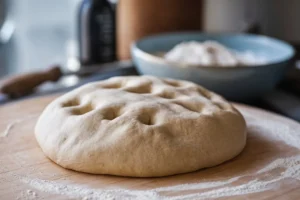Making pizza dough in advance can be a game-changer for those who love the taste of freshly baked, homemade pizza but don’t always have the time to start from scratch. Whether you’re a seasoned pizzaiolo or a home cook using an Ooni pizza oven, understanding how to prepare and store your dough in advance can save you time and effort while still delivering delicious results.
Why Make Pizza Dough in Advance?
There are several reasons why making pizza dough in advance is beneficial:
- Time Management: Preparing dough ahead of time allows you to spread out the labor-intensive process. This is especially helpful when you’re planning to make pizzas for a large group or event.
- Flavor Development: Allowing the dough to ferment and rest for an extended period can enhance the flavor and texture of your pizza. The slow fermentation process breaks down the gluten, leading to a more complex, slightly tangy flavor profile.
- Convenience: Having dough ready to go means you can whip up a pizza whenever the craving strikes, without the need to wait for the dough to rise.
The Science Behind Pizza Dough Fermentation
Fermentation is a crucial part of making pizza dough, and it’s where a lot of the flavor is developed. When yeast ferments the sugars in the flour, it produces carbon dioxide gas, which gets trapped in the dough and causes it to rise. The longer the fermentation process, the more time the yeast has to break down the sugars and develop more complex flavors.
Making dough in advance and allowing it to ferment slowly in the refrigerator (cold fermentation) can lead to superior pizza dough. The colder temperature slows down the yeast activity, allowing for a more gradual fermentation process, which enhances both the flavor and texture of the dough.
Step-by-Step Guide to Making Ooni Pizza Dough in Advance
Here’s a step-by-step guide to making Ooni pizza dough in advance, including tips on how to store it properly.
Ingredients
To make pizza dough for your Ooni oven, you’ll need the following ingredients:
- 500g of strong white bread flour: This type of flour has a higher protein content, which helps develop gluten and gives the dough its structure.
- 325ml of water: The water hydrates the flour and activates the yeast. It should be lukewarm (around 105°F or 40°C) to help the yeast activate.
- 10g of salt: Salt adds flavor and strengthens the gluten structure.
- 7g of dried yeast: Yeast is what makes the dough rise. Instant yeast is convenient for making dough in advance.
- 10g of olive oil: This adds flavor and makes the dough more elastic.
Instructions
- Mix the Ingredients: Start by mixing the flour, salt, and yeast in a large bowl. Slowly add the water while mixing until the ingredients are combined into a rough dough.
- Knead the Dough: Transfer the dough to a lightly floured surface and knead for about 10 minutes until the dough is smooth and elastic. Kneading helps to develop the gluten, which gives the dough its chewy texture.
- First Rise (Bulk Fermentation): Place the dough in a lightly oiled bowl, cover it with a damp cloth, and let it rise at room temperature for 1-2 hours or until it has doubled in size.
- Divide and Shape the Dough: After the first rise, punch down the dough to release the gas, then divide it into portions (depending on how many pizzas you want to make). Shape each portion into a ball.
- Cold Fermentation (Refrigeration): Place the dough balls in separate, lightly oiled containers or zip-lock bags and refrigerate. The dough can be stored in the refrigerator for up to 72 hours. This slow, cold fermentation will enhance the flavor and texture of the dough.
Storing Pizza Dough in Advance

Proper storage is key to ensuring your pizza dough stays fresh and ready to use. Here are some tips:
Refrigeration
If you’re planning to use the dough within a few days, refrigeration is the best option. Here’s how to store your dough in the fridge:
- Oil the Dough Balls: Lightly coat the dough balls with olive oil to prevent them from drying out or sticking to the container.
- Use Airtight Containers: Place the dough balls in airtight containers or sealable plastic bags. Make sure there’s some room for the dough to expand.
- Label the Containers: If you’re making multiple batches, label the containers with the date they were made, so you know which dough to use first.
- Refrigeration Time: Dough can be stored in the refrigerator for up to 72 hours. After this time, the dough might start to lose its rising power and could become overly sour.
Freezing
If you want to store your dough for a longer period, freezing is an excellent option. Here’s how to do it:
- Pre-freeze the Dough Balls: After shaping the dough into balls, place them on a baking sheet lined with parchment paper and freeze for about an hour. This prevents the dough from sticking together when you transfer them to a storage container.
- Transfer to Freezer Bags: Once the dough balls are firm, transfer them to freezer bags. Squeeze out as much air as possible before sealing the bags.
- Label and Store: Label the bags with the date and store them in the freezer. Pizza dough can be frozen for up to 3 months.
- Thawing the Dough: To use, transfer the dough from the freezer to the refrigerator and let it thaw slowly overnight. Alternatively, you can let it thaw at room temperature for a few hours.
Tips for Using Pre-made Pizza Dough
Using pizza dough that you’ve made in advance is convenient, but it requires a bit of care to ensure it’s just as good as freshly made dough. Here are some tips:
- Bring to Room Temperature: Before using refrigerated or thawed dough, let it sit at room temperature for about 30 minutes. This makes it easier to stretch and shape.
- Avoid Overworking the Dough: Handle the dough gently to avoid knocking out too much of the gas that has formed during fermentation. Overworking can result in a dense crust.
- Use Plenty of Flour: When shaping the dough, use plenty of flour on your work surface to prevent sticking.
- Preheat the Ooni Oven: Ensure your Ooni pizza oven is fully preheated before baking. The high heat is essential for achieving a crispy crust and properly cooked toppings.
- Experiment with Different Fermentation Times: Depending on your taste preference, you can experiment with different fermentation times to find the balance of flavor and texture that you like best.
Frequently Asked Questions
1. How Long Can I Store Pizza Dough in the Fridge?
You can store pizza dough in the fridge for up to 72 hours. After this period, the dough may begin to lose its elasticity and rising power, and the flavor might become too sour. However, some pizza enthusiasts prefer dough that has fermented for a longer time, as it can develop a more complex flavor. If you’re planning to store the dough for more than 72 hours, freezing it is a better option.
2. Can I Freeze Pizza Dough with Active Yeast?
Yes, you can freeze pizza dough made with active yeast. Yeast can survive freezing temperatures, though its activity will be paused while frozen. When you thaw the dough, the yeast will reactivate, and the dough will rise as usual. Make sure to freeze the dough after it has completed its first rise (bulk fermentation) but before you shape it for baking.
3. Is Cold Fermentation Better Than Room Temperature Fermentation?
Cold fermentation is often preferred because it slows down the yeast activity, allowing for a more gradual development of flavors. Dough that has been cold-fermented tends to have a more complex, slightly tangy flavor and a better texture compared to dough that has been fermented at room temperature. Room temperature fermentation is faster but may not produce the same depth of flavor.
4. What Should I Do If My Dough Doesn’t Rise After Being Refrigerated?
If your dough doesn’t rise after being refrigerated, it could be due to several factors. First, check the expiration date of your yeast; expired yeast might not be active enough to leaven the dough. Additionally, if the dough was kept in the refrigerator for too long, the yeast may have exhausted its food supply and become inactive. In this case, it’s best to start with a fresh batch of dough.
5. Can I Use Whole Wheat Flour Instead of White Flour?
Yes, you can use whole wheat flour instead of white flour, but it will result in a denser dough with a nuttier flavor. Whole wheat flour contains more fiber and nutrients than white flour, making it a healthier option. However, because it absorbs more water, you may need to adjust the hydration level by adding a little more water to the dough. Be prepared for a slightly different texture and taste.
The Best Tools for Making and Storing Pizza Dough
Having the right tools can make the process of making pizza dough in advance much easier. Here are some recommended tools:
- Stand Mixer with Dough Hook: A stand mixer with a dough hook attachment can save you a lot of time and effort when kneading dough, especially if you’re making a large batch.
- Dough Scraper: This handy tool makes it easier to handle sticky dough and divide it into portions.
- Airtight Containers: Invest in high-quality, airtight containers for storing dough in the refrigerator. They help keep the dough fresh and prevent it from absorbing any fridge odors.
- Pizza Stone or Steel: For baking, a pizza stone or steel is essential for achieving a crispy crust in your Ooni oven. These tools help distribute heat evenly across the dough.
- Digital Kitchen Scale: Accuracy is key in baking, and a digital kitchen scale ensures you measure your ingredients precisely.
Pairing Suggestions for Ooni Pizza

The beauty of pizza is that it pairs well with a variety of sides and beverages. Here are some suggestions:
Sides
- Arugula Salad: A fresh arugula salad with lemon vinaigrette provides a zesty contrast to the rich flavors of pizza.
- Garlic Bread: Simple yet satisfying, garlic bread is a classic side that complements pizza beautifully.
- Roasted Vegetables: Roasted bell peppers, zucchini, and cherry tomatoes can be served on the side or even added as toppings.
Beverages
- Italian Red Wine: A full-bodied Italian red wine, such as Chianti or Barolo, pairs well with the rich flavors of pizza.
- Craft Beer: A hoppy IPA or a crisp lager can balance the savory flavors of the pizza.
- Sparkling Water with Lemon: For a non-alcoholic option, sparkling water with a slice of lemon cleanses the palate between bites.
Nutritional Insights
Pizza dough is relatively simple, but it provides a substantial base for the meal. Here’s a brief overview of its nutritional components:
- Carbohydrates: The main component of pizza dough, providing energy.
- Protein: Found in the flour, especially in bread flour, which has a higher protein content.
- Fat: Added through olive oil, which also contributes to the dough’s texture.
- Fiber: More prevalent in dough made with whole wheat flour.
To make a healthier pizza, consider using whole grain flour, adding a variety of vegetables as toppings, and limiting the amount of cheese.
Conclusion
Making Ooni pizza dough in advance is not only possible but also recommended for those who want to enjoy delicious homemade pizza without the last-minute rush. By understanding the science of dough fermentation and using the proper storage techniques, you can prepare your dough days ahead and still achieve a pizza that rivals those from your favorite pizzerias. Whether you refrigerate or freeze your dough, the key is to plan ahead, use quality ingredients, and give your dough the time it needs to develop its full flavor potential.
With these tips and techniques, you’re well on your way to mastering the art of homemade pizza. Enjoy the process, experiment with different fermentation times and ingredients, and most importantly, savor the delicious results!

